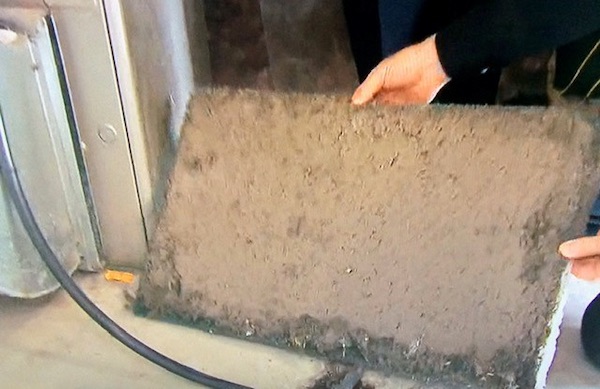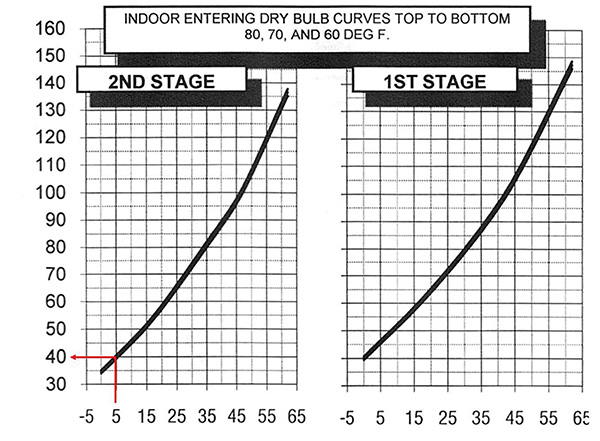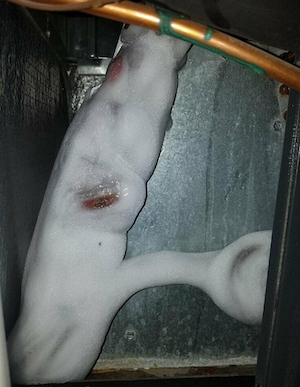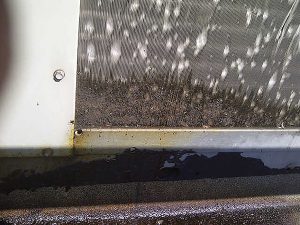
The Trouble with Low Suction Pressure
July 20, 2021 | By Ian McTeer
A healthy refrigeration cycle requires close monitoring of pressures, both high and low.

As pumps go nothing compares to the incredible heart muscle within our bodies circulating blood ceaselessly “lub-dub” throughout our vast network of arteries and veins for decades, sometimes even a century.
In the mechanical world a hydronic circulating pump might be a close comparison, since both pumps move only liquids without too much complaint until, of course, something goes wrong. A refrigeration compressor moves only vapour with ease, but like the human heart it might succumb to a total failure when too many things get out of hand.
The human body, like a refrigeration system, allows a practitioner to make diagnostic decisions by monitoring pressures gleaned from a blood pressure cuff. Systolic pressure, the higher number, gives an indication of how hard the heart is working to force blood through the arteries. The bottom number, diastolic pressure, indicates pressure as the heart relaxes between beats.
Physicians typically look for systolic blood pressure to measure approximately 120 mm Hg (millimeters of mercury) and 80 mm Hg diastolic pressure: 120/80 is normal blood pressure. Everyone should know by now that high blood pressure is dangerous. It’s much like high head pressure in a refrigeration system, elevated numbers mean something is very wrong. Strokes and heart attacks in humans follow from untreated high blood pressure, while nasty burnouts and otherwise poor performance is associated with high refrigerant system pressure.
But what about low pressure? In the human body, for too long physicians have emphasized high-pressure-related problems, but new studies show that low diastolic pressure is equally worrisome. For example, one condition that could contribute to low blood pressure is dehydration. A technician working outside in the hot sun, sweating up a storm, stands up suddenly and feels dizzy, that is potentially a sign of low diastolic pressure, under 90 mm Hg.
Now, do not take any medical advice from a layman like me, I’m simply quoting from the literature: if you’re experiencing dizziness, do not read the rest of my column, call your doctor!
Just like a refrigeration system, there are plenty of reasons why your blood pressure might be too low.
What Should the Suction Pressure Be?
Manufacturers of residential air conditioners have published charts and tables included with cooling equipment that specifies desired suction and head pressures over a wide range of outdoor dry bulb temperatures and indoor wet bulb temperatures for as long as I can remember.
While the indoor coil appears to be a conglomeration of copper tubes and extended surface metal fins, it is also a highly engineered matched component in the refrigeration system. Today’s highest efficiency evaporator coils come in metal-cased cabinets ensuring the best possible airflow over the coil by reducing air leakage from around the base of the coil.
The evaporator coil is an area of low heat energy that must be maintained so that heat will flow from the surrounding air into the low temperature liquid along a declining temperature gradient ensuring that heat picked up from the airstream will completely evaporate liquid refrigerant into vapour. The process is designed to work in concert with the heart of any refrigeration system: the compressor.
Vapour must be removed from the evaporator at a rate that permits conditions inside the evaporator to remain at lower temperature and pressure, a condition known as steady state. The compressor will then discharge vapour at a temperature and pressure high enough to permit heat rejection inside the outdoor coil.
Every mechanical refrigeration system, be it in a low-, medium-, or high-temperature application, is engineered to absorb and to reject specific amounts of heat. In a high-temperature application, such as a residential air conditioner, the equipment manufacturer will provide data showing expected suction pressure and head pressure values based on dry bulb air temperature across the outdoor coil and wet bulb temperature across the indoor coil.

Figure 1. Example of a manufacturer’s chart for cooling cycle pressure curve (example only, use the chart specific to the unit you’re working on).
In the example chart (Figure 1, for demonstration only, be sure to always use your manufacturer’s charts and tables), a technician measures the dry bulb temperature entering the outdoor coil at 85F and the wet/dry bulb temperature entering the indoor coil at 72F-DB and 60F-WB.
The technician extends the outdoor ambient line from 85F over to the left side of the chart, indicating a discharge pressure of approximately 320 pounds-per-square-inch-gauge (psig) would be ideal under these measured conditions.
Since the chart does not present the exact indoor conditions, the technician adds a line between the given data marked in red. Dropping another red line from the intersection of the indoor line and the outdoor line, suction pressure under these conditions should be approximately 128 psig. Manufacturers typically allow some variance, say +/- 10 psig on the head pressure and +/- 3 psig on the suction pressure are common values.
Also, in Figure 1, note the additional system performance requirements: system must be in high stage with indoor airflow at 400 cfm per ton, otherwise this chart may not be useful.

Figure 2.
The chart in Figure 2 indicates what pressures to expect when using the example data provided by the manufacturer. In this case, an electronic expansion valve is being used. Wet bulb curves on the suction chart are far apart, technicians may have to interpolate values measured in the field by drawing in a suitable curve.
The manufacturer also specifies the size of interconnecting tubing needed for this split system and provides a pressure variance. In this example case, expect a suction pressure of 140 psig.

Figure 3. A specific heat pump application example chart.
The chart in Figure 3 is used with a specific heat pump application. Regardless of the indoor air temperature entering the air handler/furnace coil, the suction pressure measured at the outdoor coil (now the evaporator coil) in second stage operation should be approximately 40 psig when the air entering the outdoor coil is 5F.
Why is the suction pressure too low?
At one time, technicians took for granted that an R-22 evaporator ran a design temperature difference of 35F, thus if the coil air entering temperature was 75F, then the design temperature difference of 35F meant the target evaporator coil temperature should be 40F.

Figure 4. Coil temperature drops below freezing.
An R-22 evaporator running at 40F saturation temperature will have a corresponding pressure of 68.5 psig. Should the suction pressure drop below 57 psig, the coil temperature will drop below 32F causing moisture in the air to freeze on it (see Figure 4) causing no end of trouble. A R-410A evaporator running below 100 psig will freeze-up just like its R-22 cousin.
One of the most common causes of low suction pressure is loss of critical refrigerant charge caused by small leaks over time.

Figure 5. Refrigerant leak.
Finding and repairing system leaks accounts for a significant amount of an HVAC technician’s day (Figure 5).
Let’s take a look at other possible causes. Low suction pressure problems can be divided into two subcategories — low suction/high superheat and low suction/low superheat:
Low suction/high superheat:
- Moisture, dirt, or wax buildup in critical areas, especially the metering device. In Figure 6, this fixed metering device is 30% blocked.
- Loss of TXV thermostatic element charge
- Incorrect element charge or contaminated element wadding
- TXV external equalizer line restricted or capped off (see Figure 7)
- Internally equalized valve used when external equalizer required (Fig. 7)
- Undersized valve
- Faulty TXV

Figure 7
Vapour in the liquid line caused by excessive vertical lift causes low suction pressure and high superheat. A TXV can only meter liquid, so flash gas in the liquid line must be prevented. If the manufacturer states maximum lift is 60 feet, find a way to get the units closer together when an installation needs extremely high lift: do not exceed maximum vertical lift on suction or liquid lines.
High friction losses related to excessive horizontal line length or utilizing undersized liquid lines will cause flash gas and high superheat. Liquid lines running through hot attics suffer from loss of subcooling creating flash gas—insulate liquid lines in such cases or avoid such locations entirely. A plugged filter drier or TXV strainer will inevitably reduce suction pressure.
In a heat pump application, the same issues may apply to the outdoor coil. This outdoor coil uses an electronic expansion valve (Figure 8). Problems related to the stepper motor and EEV control board can cause the outdoor coil to freeze solid making ice removal and defrosting a difficult task in mid-winter. The EEV board in Figure 8 has a test function (circled in red) allowing the technician to drive the valve stepper motor to the fully open position and to a nearly closed condition. During the test process, the technician can monitor pressure and superheat readings to be sure the valve is operating properly.

Figure 8
Low suction pressure/low superheat:
Apart from refrigerant leaks causing loss of critical charge, the most common problem associated with low suction pressure is: LOW LOAD, i.e., not enough warm, moisture laden airflow across the evaporator coil. Classic causes:
- Undersized duct or poorly designed and/or poorly installed air distribution system.
- Wrong fan speed.
- Large evaporator stuffed into a small plenum then tightly wrapped in sheet metal and tape.
- Air entering the evaporator is too cold.
- Lack of maintenance, dirty blower wheels, plugged secondary heat exchanger coils, blocked evaporator coils (Figure 9).
- Misapplied air filtration products leading to excessive pressure drop not preordained for the air distribution system.

Figure 9. Low load culprits.
Other low load issues:
- Improper compressor-evaporator balance: the system is not and AHRI match.
- Evaporator is oil logged caused by frequent refrigerant refills instead of proper leak repair.
High Efficiency Equipment
Ever since the Arab Oil Embargo of 1973, the HVAC industry has been on a path of ever-increasing gains in heating and cooling system operating efficiencies. Among other things, HVAC manufacturers have dramatically increased condenser and evaporator coil physical dimensions, many conventional evaporator coils are just as tall as the AHRI-matched gas furnace component.
Today’s refrigeration compressors have been tweaked to operate at lower compression ratios producing a higher SEER rating and thus reducing power consumption.
Use of unmatched components may also cause a low suction pressure issue even if the head pressure is correct (charge level meets manufacturer’s subcooling parameter) and the indoor airflow has been verified.
Refrigeration system pressures must be verified at start-up under suitable conditions as specified by the equipment manufacturer. Enough run time must be allowed (at least 15 minutes) for the system to achieve steady state operation before starting data collection.
When refrigerant must be added, allow additional run time for the system to respond to more refrigerant. And, of course, maintenance. End-users should be instructed on how to keep the outdoor unit clear of debris and vegetation along with regularly scheduled air handler filter maintenance (Figure 10).

Figure 10. Filter change.
Fortunately, the HVAC service technician will never have to worry about a compressor becoming dizzy due to low suction pressure. Nonetheless, low pressure, whether the human kind or diagnosed in a machine, must be thoroughly investigated.
Nursing a failing system back to healthy operating pressures is thus all in a day’s work. <>

 Ian McTeer is an HVAC consultant with 35 years of experience in the industry. He was most recently a field rep for Trane Canada DSO. McTeer is a refrigeration mechanic and Class 1 Gas technician.
Ian McTeer is an HVAC consultant with 35 years of experience in the industry. He was most recently a field rep for Trane Canada DSO. McTeer is a refrigeration mechanic and Class 1 Gas technician.


